Impact of AI and Machine Learning on Business Analyst Roles
VerifiedAdded on 2022/11/23
|6
|1331
|286
Essay
AI Summary
This essay examines the significant transformations occurring in the field of business analysis, primarily driven by advancements in artificial intelligence (AI) and machine learning. It explores how these technologies are reshaping the roles and responsibilities of business analysts, impacting their traditional functions and introducing new demands. The paper delves into the ways AI is used to analyze data, identify weaknesses, and inform strategic decisions, highlighting the need for analysts to adapt and acquire new skills. It discusses how machine learning is increasingly employed to solve complex business challenges and handle large datasets, leading to a shift in the required expertise of business analysts. The essay also addresses the impact of automation and digitalization on the profession, including potential job displacement and the need for analysts to focus on data interpretation and strategic guidance. The paper concludes by emphasizing the ongoing evolution of business analyst roles and the importance of staying abreast of technological advancements to remain relevant in the industry.
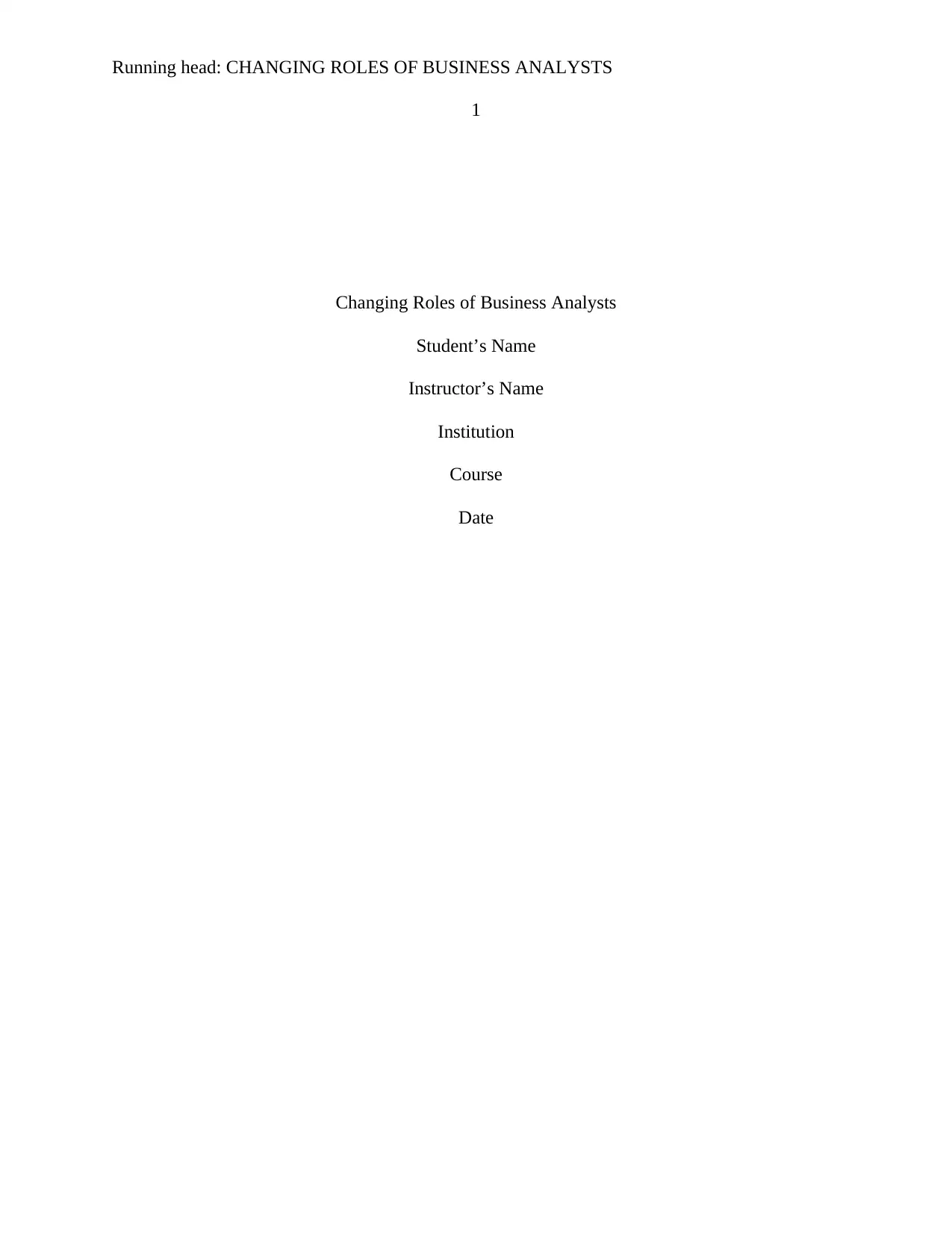
Running head: CHANGING ROLES OF BUSINESS ANALYSTS
1
Changing Roles of Business Analysts
Student’s Name
Instructor’s Name
Institution
Course
Date
1
Changing Roles of Business Analysts
Student’s Name
Instructor’s Name
Institution
Course
Date
Paraphrase This Document
Need a fresh take? Get an instant paraphrase of this document with our AI Paraphraser
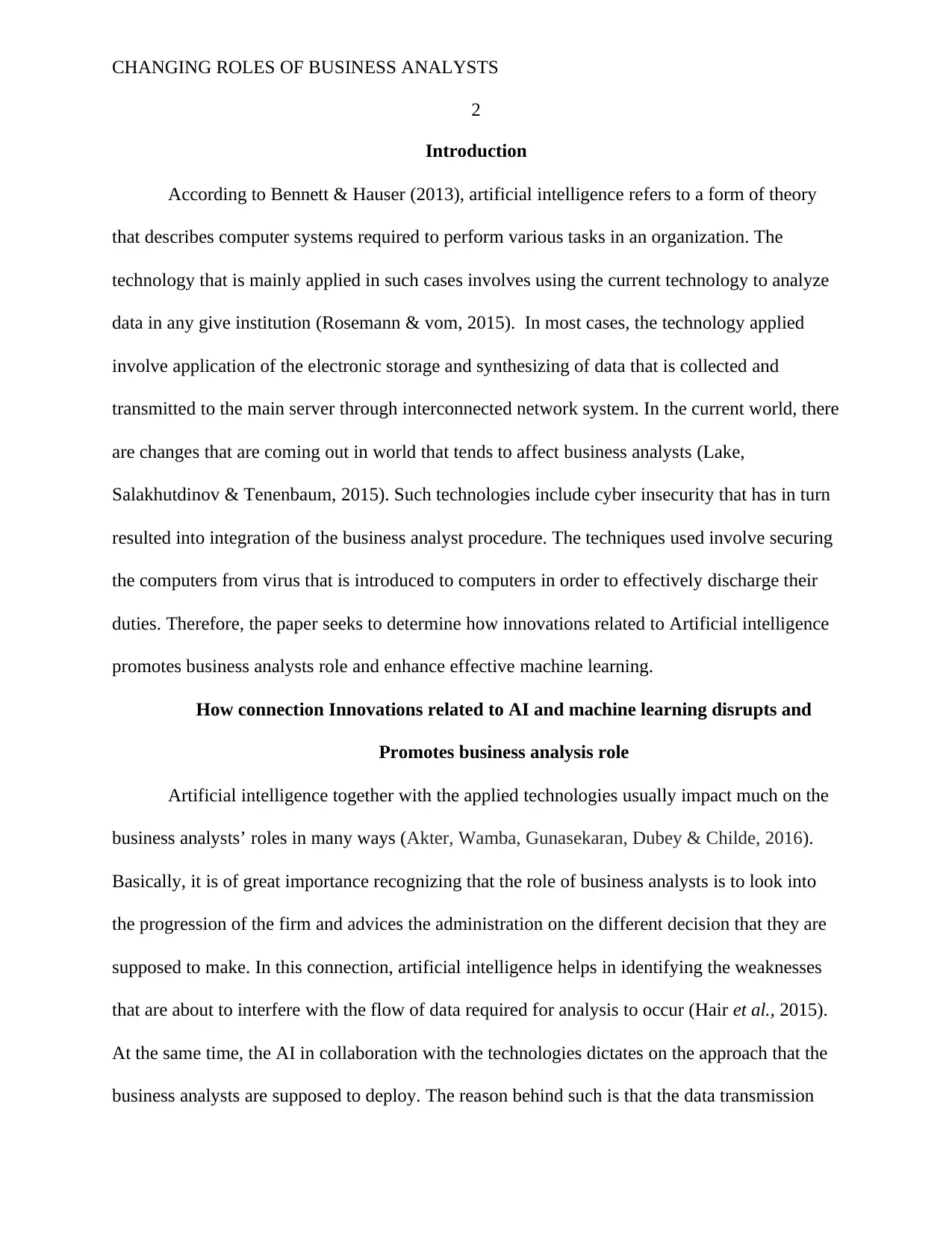
CHANGING ROLES OF BUSINESS ANALYSTS
2
Introduction
According to Bennett & Hauser (2013), artificial intelligence refers to a form of theory
that describes computer systems required to perform various tasks in an organization. The
technology that is mainly applied in such cases involves using the current technology to analyze
data in any give institution (Rosemann & vom, 2015). In most cases, the technology applied
involve application of the electronic storage and synthesizing of data that is collected and
transmitted to the main server through interconnected network system. In the current world, there
are changes that are coming out in world that tends to affect business analysts (Lake,
Salakhutdinov & Tenenbaum, 2015). Such technologies include cyber insecurity that has in turn
resulted into integration of the business analyst procedure. The techniques used involve securing
the computers from virus that is introduced to computers in order to effectively discharge their
duties. Therefore, the paper seeks to determine how innovations related to Artificial intelligence
promotes business analysts role and enhance effective machine learning.
How connection Innovations related to AI and machine learning disrupts and
Promotes business analysis role
Artificial intelligence together with the applied technologies usually impact much on the
business analysts’ roles in many ways (Akter, Wamba, Gunasekaran, Dubey & Childe, 2016).
Basically, it is of great importance recognizing that the role of business analysts is to look into
the progression of the firm and advices the administration on the different decision that they are
supposed to make. In this connection, artificial intelligence helps in identifying the weaknesses
that are about to interfere with the flow of data required for analysis to occur (Hair et al., 2015).
At the same time, the AI in collaboration with the technologies dictates on the approach that the
business analysts are supposed to deploy. The reason behind such is that the data transmission
2
Introduction
According to Bennett & Hauser (2013), artificial intelligence refers to a form of theory
that describes computer systems required to perform various tasks in an organization. The
technology that is mainly applied in such cases involves using the current technology to analyze
data in any give institution (Rosemann & vom, 2015). In most cases, the technology applied
involve application of the electronic storage and synthesizing of data that is collected and
transmitted to the main server through interconnected network system. In the current world, there
are changes that are coming out in world that tends to affect business analysts (Lake,
Salakhutdinov & Tenenbaum, 2015). Such technologies include cyber insecurity that has in turn
resulted into integration of the business analyst procedure. The techniques used involve securing
the computers from virus that is introduced to computers in order to effectively discharge their
duties. Therefore, the paper seeks to determine how innovations related to Artificial intelligence
promotes business analysts role and enhance effective machine learning.
How connection Innovations related to AI and machine learning disrupts and
Promotes business analysis role
Artificial intelligence together with the applied technologies usually impact much on the
business analysts’ roles in many ways (Akter, Wamba, Gunasekaran, Dubey & Childe, 2016).
Basically, it is of great importance recognizing that the role of business analysts is to look into
the progression of the firm and advices the administration on the different decision that they are
supposed to make. In this connection, artificial intelligence helps in identifying the weaknesses
that are about to interfere with the flow of data required for analysis to occur (Hair et al., 2015).
At the same time, the AI in collaboration with the technologies dictates on the approach that the
business analysts are supposed to deploy. The reason behind such is that the data transmission
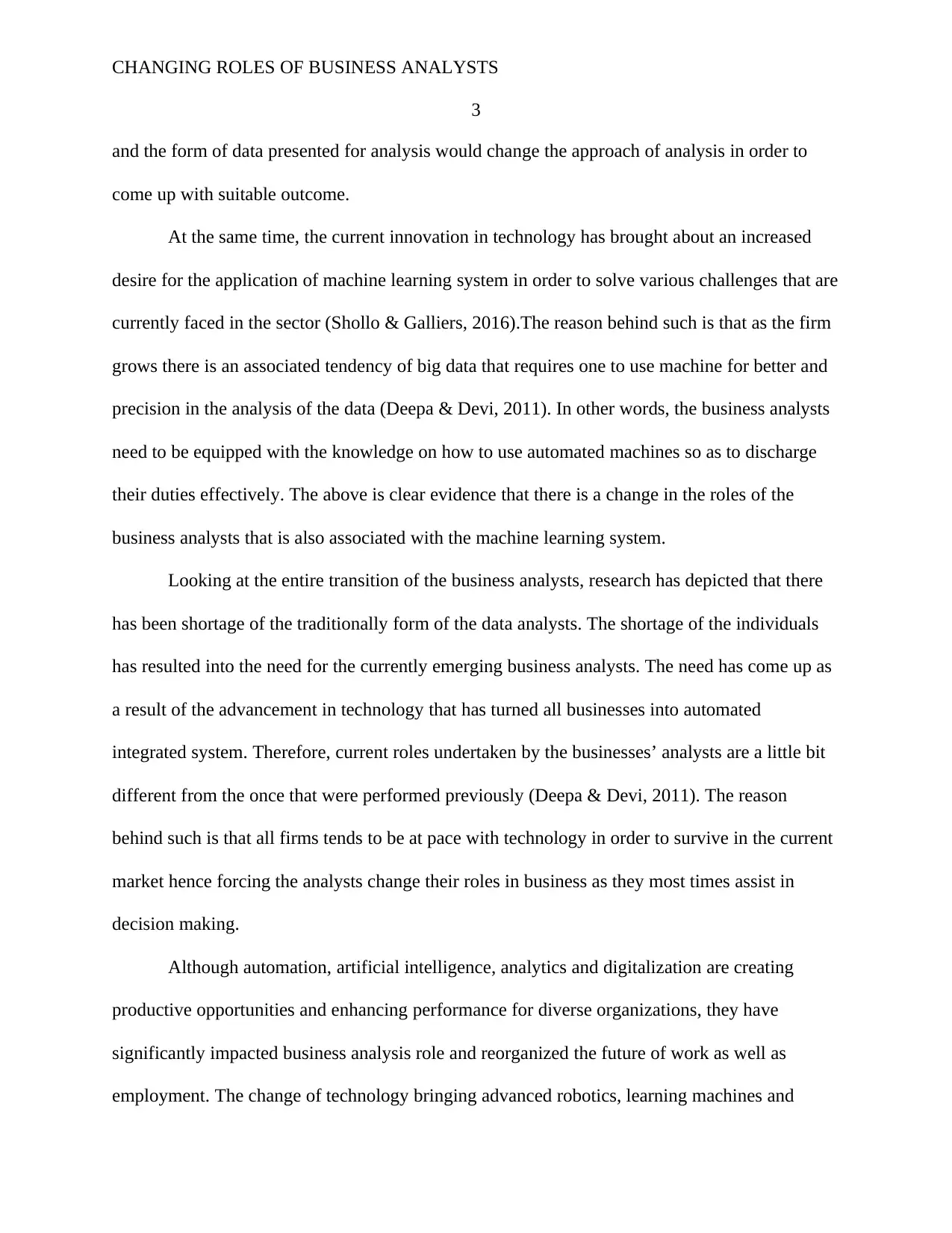
CHANGING ROLES OF BUSINESS ANALYSTS
3
and the form of data presented for analysis would change the approach of analysis in order to
come up with suitable outcome.
At the same time, the current innovation in technology has brought about an increased
desire for the application of machine learning system in order to solve various challenges that are
currently faced in the sector (Shollo & Galliers, 2016).The reason behind such is that as the firm
grows there is an associated tendency of big data that requires one to use machine for better and
precision in the analysis of the data (Deepa & Devi, 2011). In other words, the business analysts
need to be equipped with the knowledge on how to use automated machines so as to discharge
their duties effectively. The above is clear evidence that there is a change in the roles of the
business analysts that is also associated with the machine learning system.
Looking at the entire transition of the business analysts, research has depicted that there
has been shortage of the traditionally form of the data analysts. The shortage of the individuals
has resulted into the need for the currently emerging business analysts. The need has come up as
a result of the advancement in technology that has turned all businesses into automated
integrated system. Therefore, current roles undertaken by the businesses’ analysts are a little bit
different from the once that were performed previously (Deepa & Devi, 2011). The reason
behind such is that all firms tends to be at pace with technology in order to survive in the current
market hence forcing the analysts change their roles in business as they most times assist in
decision making.
Although automation, artificial intelligence, analytics and digitalization are creating
productive opportunities and enhancing performance for diverse organizations, they have
significantly impacted business analysis role and reorganized the future of work as well as
employment. The change of technology bringing advanced robotics, learning machines and
3
and the form of data presented for analysis would change the approach of analysis in order to
come up with suitable outcome.
At the same time, the current innovation in technology has brought about an increased
desire for the application of machine learning system in order to solve various challenges that are
currently faced in the sector (Shollo & Galliers, 2016).The reason behind such is that as the firm
grows there is an associated tendency of big data that requires one to use machine for better and
precision in the analysis of the data (Deepa & Devi, 2011). In other words, the business analysts
need to be equipped with the knowledge on how to use automated machines so as to discharge
their duties effectively. The above is clear evidence that there is a change in the roles of the
business analysts that is also associated with the machine learning system.
Looking at the entire transition of the business analysts, research has depicted that there
has been shortage of the traditionally form of the data analysts. The shortage of the individuals
has resulted into the need for the currently emerging business analysts. The need has come up as
a result of the advancement in technology that has turned all businesses into automated
integrated system. Therefore, current roles undertaken by the businesses’ analysts are a little bit
different from the once that were performed previously (Deepa & Devi, 2011). The reason
behind such is that all firms tends to be at pace with technology in order to survive in the current
market hence forcing the analysts change their roles in business as they most times assist in
decision making.
Although automation, artificial intelligence, analytics and digitalization are creating
productive opportunities and enhancing performance for diverse organizations, they have
significantly impacted business analysis role and reorganized the future of work as well as
employment. The change of technology bringing advanced robotics, learning machines and
⊘ This is a preview!⊘
Do you want full access?
Subscribe today to unlock all pages.

Trusted by 1+ million students worldwide
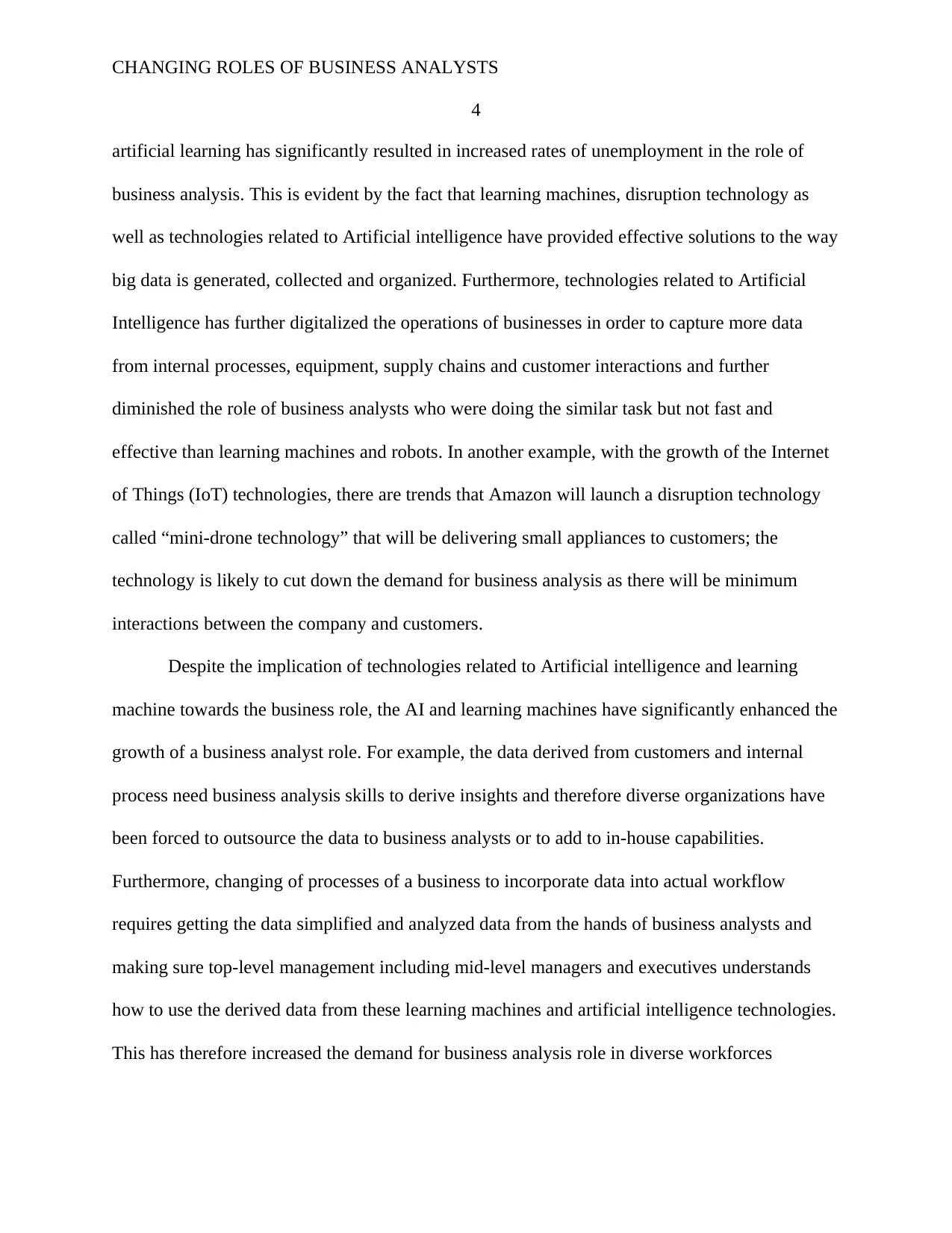
CHANGING ROLES OF BUSINESS ANALYSTS
4
artificial learning has significantly resulted in increased rates of unemployment in the role of
business analysis. This is evident by the fact that learning machines, disruption technology as
well as technologies related to Artificial intelligence have provided effective solutions to the way
big data is generated, collected and organized. Furthermore, technologies related to Artificial
Intelligence has further digitalized the operations of businesses in order to capture more data
from internal processes, equipment, supply chains and customer interactions and further
diminished the role of business analysts who were doing the similar task but not fast and
effective than learning machines and robots. In another example, with the growth of the Internet
of Things (IoT) technologies, there are trends that Amazon will launch a disruption technology
called “mini-drone technology” that will be delivering small appliances to customers; the
technology is likely to cut down the demand for business analysis as there will be minimum
interactions between the company and customers.
Despite the implication of technologies related to Artificial intelligence and learning
machine towards the business role, the AI and learning machines have significantly enhanced the
growth of a business analyst role. For example, the data derived from customers and internal
process need business analysis skills to derive insights and therefore diverse organizations have
been forced to outsource the data to business analysts or to add to in-house capabilities.
Furthermore, changing of processes of a business to incorporate data into actual workflow
requires getting the data simplified and analyzed data from the hands of business analysts and
making sure top-level management including mid-level managers and executives understands
how to use the derived data from these learning machines and artificial intelligence technologies.
This has therefore increased the demand for business analysis role in diverse workforces
4
artificial learning has significantly resulted in increased rates of unemployment in the role of
business analysis. This is evident by the fact that learning machines, disruption technology as
well as technologies related to Artificial intelligence have provided effective solutions to the way
big data is generated, collected and organized. Furthermore, technologies related to Artificial
Intelligence has further digitalized the operations of businesses in order to capture more data
from internal processes, equipment, supply chains and customer interactions and further
diminished the role of business analysts who were doing the similar task but not fast and
effective than learning machines and robots. In another example, with the growth of the Internet
of Things (IoT) technologies, there are trends that Amazon will launch a disruption technology
called “mini-drone technology” that will be delivering small appliances to customers; the
technology is likely to cut down the demand for business analysis as there will be minimum
interactions between the company and customers.
Despite the implication of technologies related to Artificial intelligence and learning
machine towards the business role, the AI and learning machines have significantly enhanced the
growth of a business analyst role. For example, the data derived from customers and internal
process need business analysis skills to derive insights and therefore diverse organizations have
been forced to outsource the data to business analysts or to add to in-house capabilities.
Furthermore, changing of processes of a business to incorporate data into actual workflow
requires getting the data simplified and analyzed data from the hands of business analysts and
making sure top-level management including mid-level managers and executives understands
how to use the derived data from these learning machines and artificial intelligence technologies.
This has therefore increased the demand for business analysis role in diverse workforces
Paraphrase This Document
Need a fresh take? Get an instant paraphrase of this document with our AI Paraphraser
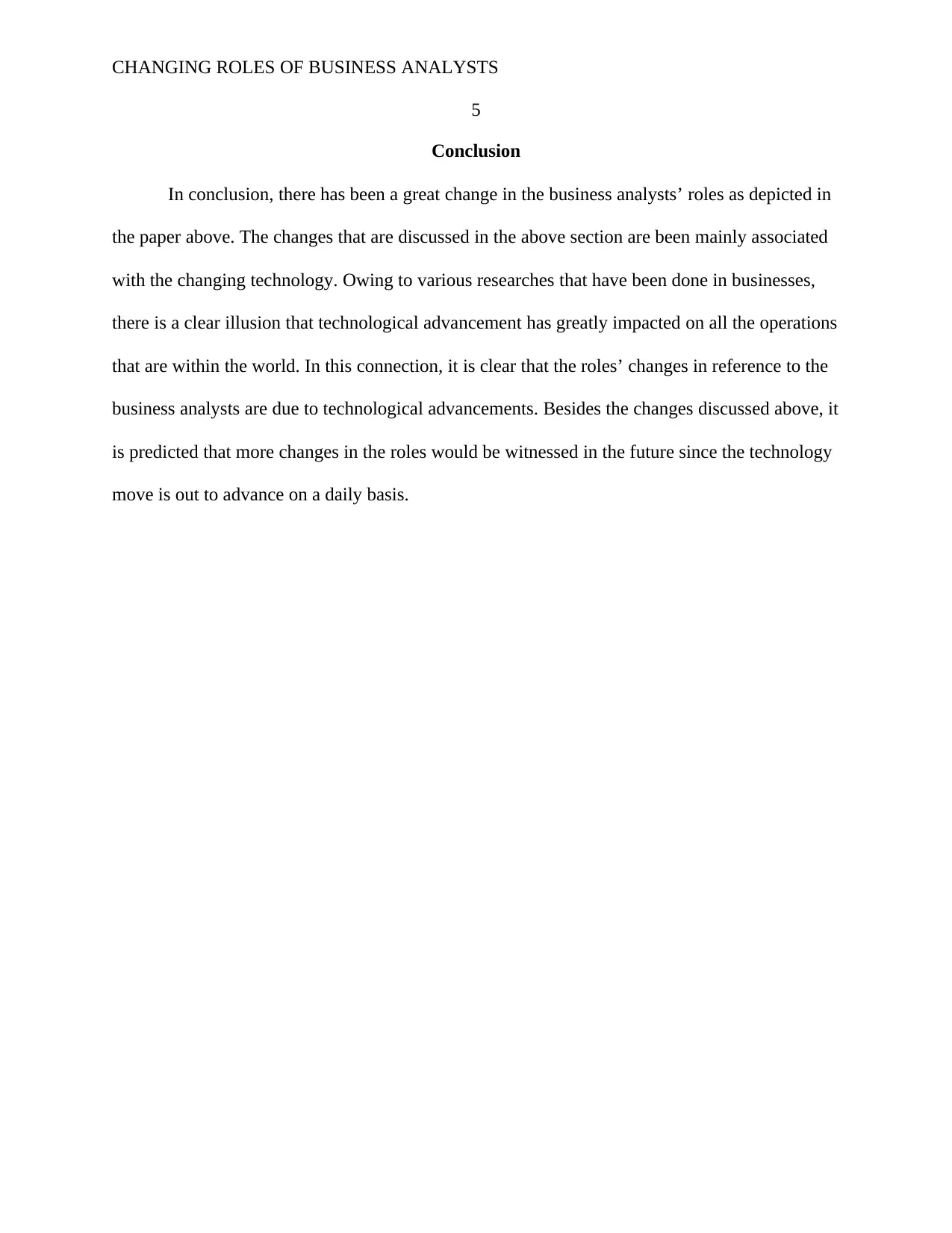
CHANGING ROLES OF BUSINESS ANALYSTS
5
Conclusion
In conclusion, there has been a great change in the business analysts’ roles as depicted in
the paper above. The changes that are discussed in the above section are been mainly associated
with the changing technology. Owing to various researches that have been done in businesses,
there is a clear illusion that technological advancement has greatly impacted on all the operations
that are within the world. In this connection, it is clear that the roles’ changes in reference to the
business analysts are due to technological advancements. Besides the changes discussed above, it
is predicted that more changes in the roles would be witnessed in the future since the technology
move is out to advance on a daily basis.
5
Conclusion
In conclusion, there has been a great change in the business analysts’ roles as depicted in
the paper above. The changes that are discussed in the above section are been mainly associated
with the changing technology. Owing to various researches that have been done in businesses,
there is a clear illusion that technological advancement has greatly impacted on all the operations
that are within the world. In this connection, it is clear that the roles’ changes in reference to the
business analysts are due to technological advancements. Besides the changes discussed above, it
is predicted that more changes in the roles would be witnessed in the future since the technology
move is out to advance on a daily basis.
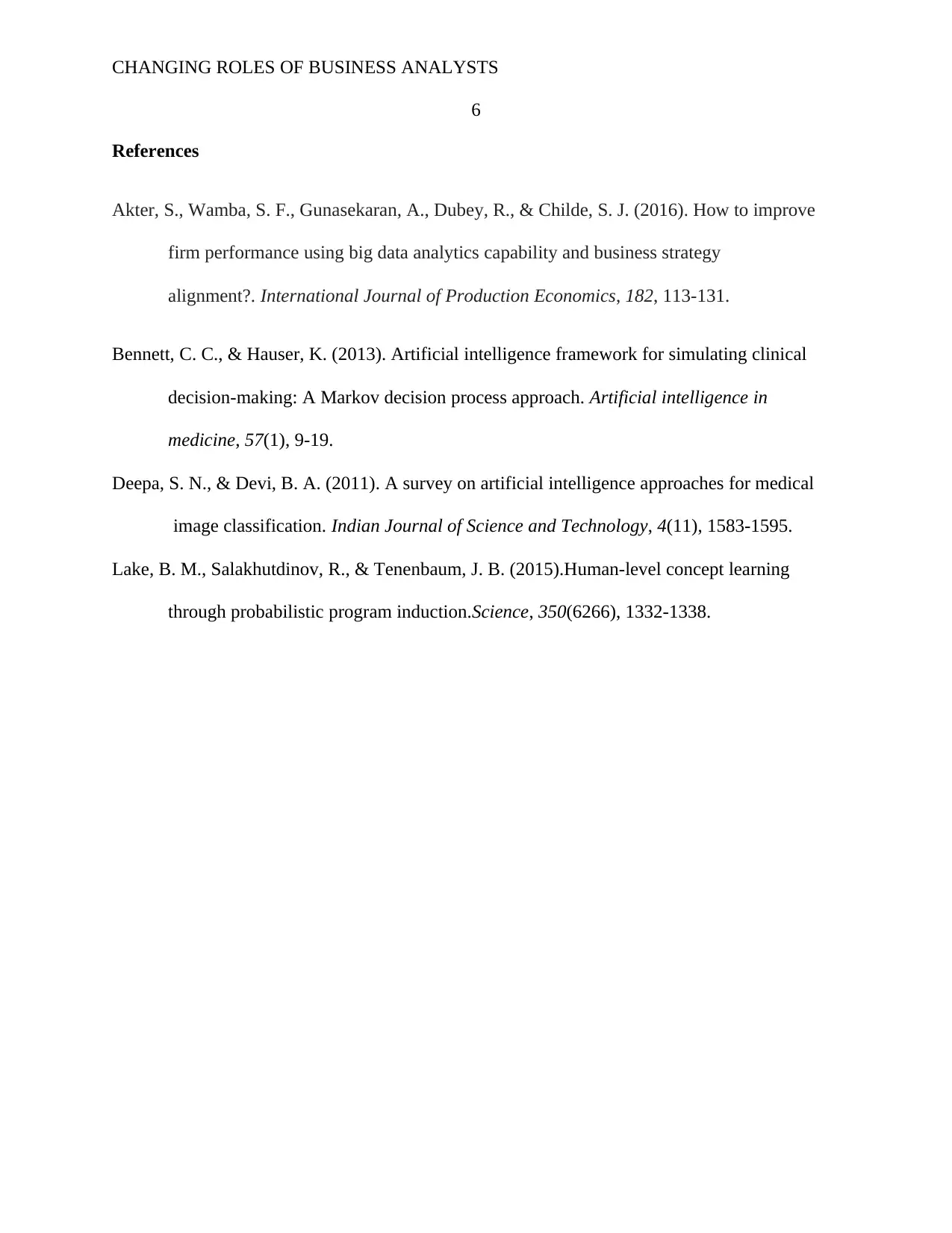
CHANGING ROLES OF BUSINESS ANALYSTS
6
References
Akter, S., Wamba, S. F., Gunasekaran, A., Dubey, R., & Childe, S. J. (2016). How to improve
firm performance using big data analytics capability and business strategy
alignment?. International Journal of Production Economics, 182, 113-131.
Bennett, C. C., & Hauser, K. (2013). Artificial intelligence framework for simulating clinical
decision-making: A Markov decision process approach. Artificial intelligence in
medicine, 57(1), 9-19.
Deepa, S. N., & Devi, B. A. (2011). A survey on artificial intelligence approaches for medical
image classification. Indian Journal of Science and Technology, 4(11), 1583-1595.
Lake, B. M., Salakhutdinov, R., & Tenenbaum, J. B. (2015).Human-level concept learning
through probabilistic program induction.Science, 350(6266), 1332-1338.
6
References
Akter, S., Wamba, S. F., Gunasekaran, A., Dubey, R., & Childe, S. J. (2016). How to improve
firm performance using big data analytics capability and business strategy
alignment?. International Journal of Production Economics, 182, 113-131.
Bennett, C. C., & Hauser, K. (2013). Artificial intelligence framework for simulating clinical
decision-making: A Markov decision process approach. Artificial intelligence in
medicine, 57(1), 9-19.
Deepa, S. N., & Devi, B. A. (2011). A survey on artificial intelligence approaches for medical
image classification. Indian Journal of Science and Technology, 4(11), 1583-1595.
Lake, B. M., Salakhutdinov, R., & Tenenbaum, J. B. (2015).Human-level concept learning
through probabilistic program induction.Science, 350(6266), 1332-1338.
⊘ This is a preview!⊘
Do you want full access?
Subscribe today to unlock all pages.

Trusted by 1+ million students worldwide
1 out of 6
Related Documents
Your All-in-One AI-Powered Toolkit for Academic Success.
+13062052269
info@desklib.com
Available 24*7 on WhatsApp / Email
![[object Object]](/_next/static/media/star-bottom.7253800d.svg)
Unlock your academic potential
Copyright © 2020–2025 A2Z Services. All Rights Reserved. Developed and managed by ZUCOL.





